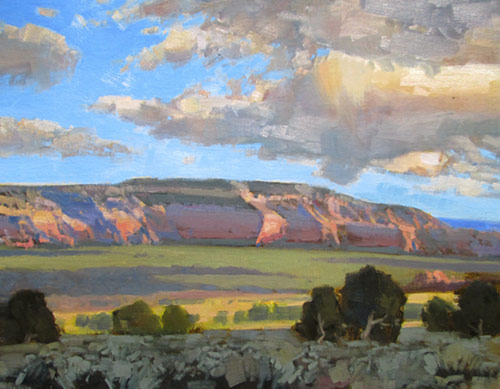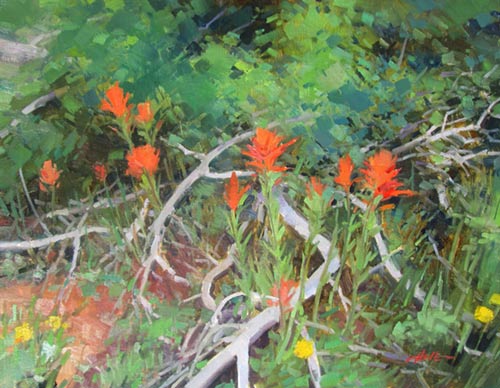In this series of articles, Utah artist J. Brad Holt talks about what artists are seeing as they look at the landscape. Holt studied geology in college and is attentive to what the rocks suggest in the scenes he paints.
Lead Image: “Zion Overlook From Blowhard Mtn,” by J. Brad Holt, 2015, oil, 12 x 12 in.
The fossil record seems to indicate that life has existed on this planet for about 3.5 billion years. The earliest life appears to be prokaryotic bacteria, in which genetic material is not contained within a cell nucleus. These proto-cyanobacteria fossils have been found in ancient chert deposits in North America and Southern Africa. The spark of life may have been just that, as researchers have demonstrated the ability to synthesize amino acids by subjecting a mixture of methane and ammonia to a lengthy battery of electric sparks, meant to simulate lightning. If nothing else, this shows that the building blocks for RNA and DNA were available in the early earth environment.
The leap from these organic compounds to actual life is a big one, though, which may explain why Occam’s Razor is more ambivalent about extraterrestrial origins than one might suppose. Atmospheric oxygen is largely a byproduct of 3.5 billion years of life, which means that the earliest organisms were anaerobic. The evolution of photosynthesis led to a gradual rise in atmospheric oxygen. Though the prokaryotes were never multi-cellular, concentrated groups of them could form mats, which led to formations of lime accretions called stromatholites. Modern stromatholite accretions can still be found along certain coastlines in Australia.

When eukaryotic bacteria with well-defined cell nuclei evolved, the stage was set for multicultural life forms. This is the root of all higher life, including ourselves. About 1.5 billion years ago, multi-celled eukaryotic algae colonies developed chloroplasts to be used in photosynthesis. These are the ancestors of all plants. Life evolved at a very slow pace until just before the end of the Precambrian Era, when the first primitive animal life forms, called Edicarian Forms, appeared in the oceans.
The beginning of the Paleozoic Era 542 million years ago is often referred to as the “Cambrian Explosion” to mark the sudden increase and diversification of life. All of the major invertebrate groups made their appearance at this time. Animals with hard parts such as carbonate shells, chitinous exoskeletons, or silicon spicules appeared, which means that their fossils were more readily preserved. This might account for a measure of the suddenness with which life appeared to flourish at the beginning of the Cambrian Period. Mollusks and arthropods were particularly quick to evolve, with the rise of cephalopods, ancestors of squids and octopi, and trilobites, which were ancestors to insects. About 400 million years ago, at the end of the Silurian Period, the first primitive plants began to move out of the water onto land. Fish with internal skeletons developed and became dominant, and the first insects appeared at the close of the Devonian.

For the next hundred million years, through the Carboniferous and Permian periods, vast forests and swamps proliferated to the point that much of our coal reserves are found in rock of this age. Amphibians became dominant during this time, and early reptiles evolved. At the end of the Permian Period, one of the greatest mass extinctions occurred: Ninety percent of the life forms in the seas, and three quarters of the land-based species, died out. The reasons for this event remain a mystery. There are many theories, but little consensus on the mechanisms behind the Permian Extinction. Whatever the reasons, it did pave the way for the age of reptiles in the Mesozoic Era. Unlike amphibians, reptiles were able to move beyond the swamps, because their durable eggs allowed a totally terrestrial existence. In the plant kingdom, the evolution of gymnosperms meant that plants were able to inhabit drier lands as well.
For 160 million years, conifers and dinosaurs ruled the world. The first mammals appeared in the Triassic, the earliest birds in the Jurassic, and the first angiosperms (flowering plants) during the Cretaceous Period. The second great extinction event came at the close of the Cretaceous Period. An asteroid impact in the region of the present day Yucatan Peninsula is widely accepted as the cause. The end of the Cretaceous, and the beginning of the Tertiary Period, known as the “KT Boundary,” is marked by a worldwide occurrence of the rare element iridium, which is much more common in extraterrestrial material.

The demise of the dinosaurs made way for the Age of Mammals, although calling it the Age of Insects, Age of Birds, and Age of Flowering Plants would be just as apt: All these groups have been quite successful in the Cenozoic Era. Some interesting items about the development of mammals include the differentiation of marsupial and placental mammals. The marsupial mammals seemed to be concentrated in Australia and South America, which were separated by the mass of Antarctica during the time of Pangaea, when the earliest mammals evolved. After the break-up of Pangaea, isolation of the Australian-Indian plate seems to have allowed a divergence of evolution, with many marsupial forms becoming dominant even as they died out on some of the other continents. Some marsupials, and giant rodents, developed in isolation on the South American Plate, until the formation of the Panamanian land bridge allowed exchanging of species between the Americas. This led to the extinction of many marsupials, but, oddly enough, introduced opossums to North America, where they have thrived. The circumstances that govern the success or demise of a species are often difficult to fathom, and are not intuitive.
Very large mammals developed around 40 million years ago and dominated the grasslands, which also evolved to dominate during this period. Many of these species, including giant sloths, mastodons, mammoths, saber-toothed cats, cave bears, wooly rhinos, and giant bison have only recently become extinct, since the end of the Pleistocene. This means that our ancestors coexisted with many of these animals, and indeed hunted them for food. The last wooly mammoths, in particular, are thought to have still been alive as recently as 8,000 years ago.




